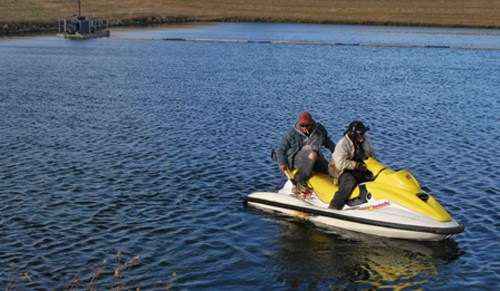Work is now underway on clearing space in Carlyle's sewage-waste lagoon following findings that the facility was reaching capacity.
Following a decision by council to take action on what was becoming a concern, the firm of Roy & Sons Dredging Services was hired on at cost of $71,000 to dredge the bottom of the lagoon.
To accompany this effort, a large pit was also dug to hold the dredged waste at a cost to the town of $40,000.
Arriving at the lagoon the father and son team of Roy and Troy Klock, along with worker James Nelson prepared their equipment for the task ahead.
"What we do is we put the dredging machine out in the lagoon, secured by line to trucks parked at either bank," explained the younger Klock of the operation. "We then run from one side to the other, covering six-foot strips at a time."
With the piles of solid waste, most of which is un-decomposed plastic and sanitary items, averaging four-feet in depth throughout the lagoon, and as deep as eight-feet at the mouth of the main sewer pipe, clearing the waste will require multiple passes.
"Our machine dredges to a depth of one-and-a-half to two-feet per go," Klock explained. "Also, we can't dredge backwards because all we will really do is move water."
In a sight that was almost surreal, the younger Klock and Nelson both climbed aboard a jet-ski floating on top of the lagoon.
Putting the ski into drive, the two sailed out to the dredging machine which was secured in the centreline of the lagoon.
"Yeah, it looks kind of funny, I know," laughed the elder Klock when asked about it. "But it is the only way to get to the dredger once it is put out to work."
"But keep in mind, if you're interested, ski-rides and trips to the dredger are free of charge!"
Once ensconced on the floating apparatus, the dredger was kicked into gear to begin its first run.
As it slowly moved forward, the long hose leading form the dredger began to fatten, then at the spout end, suspended overtop of the clearing pit, a brackish, pitch-black flow of thick material began to spurt.
"Looks like you're lucky today," Klock said with a grin. "The wind is blowing the other way."
As the dredger slowly finished its first passes, the two trucks to which the dredger was attached were moved ahead exactly six feet, allowing the process to begin again.
"We never really like giving time estimations on work like this, because you never know when you might have an equipment malfunction or bad weather," Klock said. "But it everything goes perfectly, and considering the size of this particular lagoon, we could be looking at five-to-six days at 12 hours a day."
The concern about the state of the lagoon was brought about as the town began looking at the possibility of expanding the waste handling system.
Due to the near-capacity of the settling ponds, there was worry about back-pressure through the gravity-driven system, which could lead to sewer back-ups and other problems.
The lagoon project, when completed, will allow for up to another four feet of waste to be held in the lagoon, which averages eight-to-ten feet in depth.




